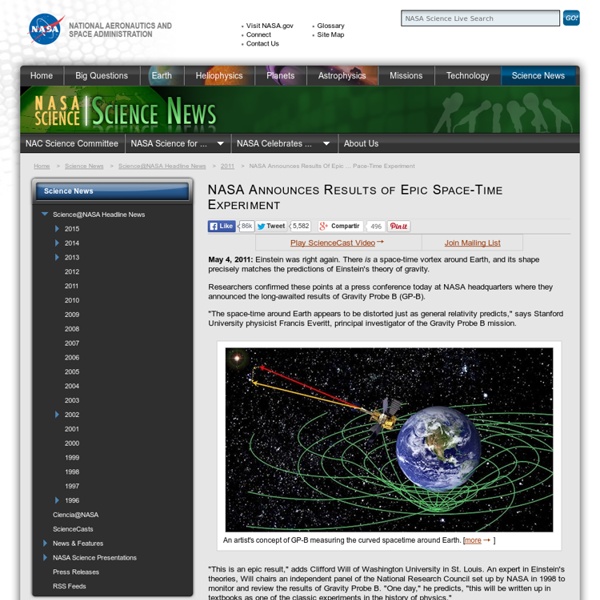Announces Results of Epic Space-Time Experiment

Pioneer anomaly
The Pioneer anomaly or Pioneer effect is the observed deviation from predicted accelerations of the Pioneer 10 and Pioneer 11 spacecraft after they passed about 20 astronomical units (3×109 km; 2×109 mi) on their trajectories out of the Solar System. The apparent anomaly was a matter of tremendous interest for many years. Both Pioneer spacecraft are escaping the Solar System, but are slowing under the influence of the Sun's gravity. Upon very close examination of navigational data, the spacecraft were found to be slowing slightly more than expected. Various explanations, both of spacecraft behavior and of gravitation itself, were proposed to explain the anomaly. Description[edit] Pioneer 10 and 11 were sent on missions to Jupiter and Jupiter/Saturn respectively. Since the spacecraft were flying with almost no additional stabilization thrusts during their "cruise", it is possible to characterize the density of the solar medium by its effect on the spacecraft's motion. Gravity[edit]
Pioneer 10
Pioneer 10 (originally designated Pioneer F) is an American space probe, weighing 258 kilograms, that completed the first mission to the planet Jupiter.[1] Thereafter, Pioneer 10 became the first spacecraft to achieve escape velocity from the Solar System. This space exploration project was conducted by the NASA Ames Research Center in California, and the space probe was manufactured by TRW. Pioneer 10 was assembled around a hexagonal bus with a 2.74 meter diameter parabolic dish high-gain antenna, and the spacecraft was spin stabilized around the axis of the antenna. Its electric power was supplied by four radioisotope thermoelectric generators that provided a combined 155 watts at launch. Pioneer 10 was launched on March 3, 1972, by an Atlas-Centaur expendable vehicle from Cape Canaveral, Florida. Between July 15, 1972, and February 15, 1973, it became the first spacecraft to traverse the asteroid belt. Mission background[edit] History[edit] Pioneer 10 in the final stages of construction
Hunt Is On for Gravity Waves in Space-Time | LIGO
Because black holes are impossible to see, one of scientists' best hopes to study them is to look for the ripples in space-time, called gravitational waves, that they are thought to create. Gravitational waves would be distortions propagating through space and time caused by violent events such as the collision of two black holes. They were first predicted by Einstein's general theory of relativity; however, scientists have yet to find one. That could change when the latest version of a gravitational wave-hunting facility gets up and running. The Laser Interferometer Gravitational Wave Observatory (LIGO) is actually a pair of observatories, in Louisiana and Washington state, that began operating in 2002. "The advanced LIGO detectors that are now being installed will see out through a substantial part of the universe," said California Institute of Technology emeritus professor of physics Kip Thorne, a leading proponent of LIGO.
Using Space-Time Distortions, Scientists Discover Hidden Galaxies
Previously hidden behind veils of dust, ancient galaxies have been detected using an effect caused by the space-time distortions in the vast distance between those galaxies and Earth. The discovery of the distant galaxies could shed light on formation of the early universe and galaxies, researchers said. [New photo of the ancient galaxies] Distant galaxies are normally difficult to see, but those whose dim light are shrouded in dust are especially difficult to detect, even using the largest available telescopes. The gravitational pull of massive intervening objects distorts space-time, an effect that can deflect light. Typically, finding gravitational lenses is very time-consuming. The objects seen in the submillimeter range are generally thought to be distant, dusty galaxies undergoing a vigorous burst of star formation. The method the researchers used was simpler than past techniques. The five galaxies the researchers found are just the tip of the iceberg, Negrello told SPACE.com.
Related:
Related:



